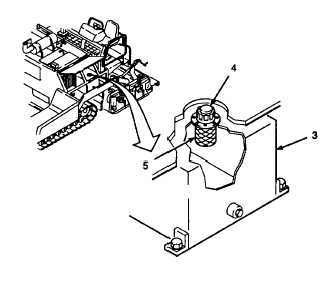TM 5-3895-373-10
b.
Turn ignition switch (1) to ON position and check
fuel gauge (2) for the amount of fuel in the fuel
tank.
c.
Open left access door per paragraph 2.24.1.
d.
Use a cleaning cloth (Item 1, Appendix D) and
wipe dirt and any foreign material from area on
top of fuel tank (3) around fuel tank cap (4).
e.
Unscrew fuel tank cap (4) and set cap aside.
Fuel is very flammable and can explode
easily.
To avoid serious injury or death: Always
wear safety glasses/goggles at all times.
Keep fuel away from open flame or any spark
(ignition source).
Keep at least a B-C fire extinguisher within
easy reach when working with fuel or on a
fuel system.
Do not work on fuel system when engine is
hot; fuel can be ignited by a hot engine.
Clean fuel tank to purge any flammable liquid
or vapors before welding, grinding, or using
any heat producing device near the fuel tank.
Post signs that read "NO SMOKING WITHIN
50 FEET" when working with open fuel lines
or fuel tanks.
CAUTION
Do not overfill fuel tank. When diesel fuel in
fuel tank begins to foam up into filler neck
the tank is full. Spilled fuel may accumulate
in hard to reach areas inside paving machine
engine compartment and cause a fire hazard.
Wipe up any spilled fuel immediately after
refueling. Dispose of contaminated rags in
accordance with local procedures.
f.
Check for any foreign material accumulated in
filler neck strainer (5). Notify Unit Maintenance if
any foreign material is observed.
g.
Place fuel nozzle into filler neck and begin
adding diesel fuel (Item 4, Appendix D).
Periodically stop fueling and check fuel gauge
for level of fuel in tank. Fuel tank is full when
gauge needle points to "1" increment mark. Do
not overfill the fuel tank; stop fueling when fuel in
tank starts to foam up into filler neck.
h.
Turn ignition switch (1) to stop position and
remove ignition key.
3-21





